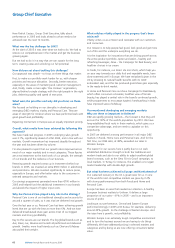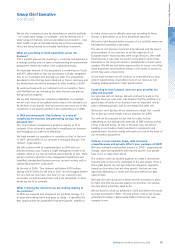Unilever 2005 Annual Report Download - page 19
Download and view the complete annual report
Please find page 19 of the 2005 Unilever annual report below. You can navigate through the pages in the report by either clicking on the pages listed below, or by using the keyword search tool below to find specific information within the annual report.16 Unilever Annual Report and Accounts 2005
Financial Review
Non-GAAP measures
Certain discussions and analyses set out in this Annual Report
and Accounts include measures which are not defined by
generally accepted accounting principles (GAAP) such as IFRSs
or US GAAP. We believe this information, along with comparable
GAAP measurements, is useful to investors because it provides a
basis for measuring our operating performance, ability to retire
debt and invest in new business opportunities. Our management
uses these financial measures, along with the most directly
comparable GAAP financial measures, in evaluating our operating
performance and value creation. Non-GAAP financial measures
should not be considered in isolation from, or as a substitute
for, financial information presented in compliance with GAAP.
Non-GAAP financial measures as reported by us may not
be comparable to similarly titled amounts reported by other
companies. Definitions of non-GAAP measures and
reconciliations to GAAP measures are provided on
pages 17 to 19.
Measures of long term value creation
Unilever’s ambition for the creation of value for shareholders is
measured by Total Shareholder Return over a rolling three year
period compared with a peer group of 20 other companies.
Unilever believes that the contribution of the business to this
objective can best be measured and communicated to investors
through the following measures:
• The delivery, over time, of Ungeared Free Cash Flow (UFCF),
which expresses the translation of profit into cash, and thus
longer term economic value; and
• The development, over time, of Return on Invested Capital
(ROIC), which expresses the returns generated on capital
invested in the company.
Unilever communicates progress against these measures annually,
and management remuneration is aligned with these objectives.
The UFCF over a three year period is incorporated as a
performance element of Unilever’s management incentive
scheme.
UFCF and ROIC are non-GAAP measures under IFRSs and US
GAAP. We include them in this respect since they are the way
in which we communicate our ambition and monitor progress
towards our longer-term value creation goals and in order to:
• Improve transparency for investors;
• Assist investors in their assessment of the long-term value of
Unilever;
• Ensure that the measures are fully understood in light of how
Unilever reviews long-term value creation for shareholders;
• Properly define the metrics used and confirm their calculation;
• Share the metrics with all investors at the same time; and
• Disclose UFCF as it is one of the drivers of management
remuneration and therefore management behaviour.
As investor measures, we believe that there are no GAAP
measures directly comparable with UFCF and ROIC. However,
in the tables on pages 17 and 18, we reconcile each as follows:
UFCF to cash flow from operating activities and also to net profit;
ROIC to net profit.
Unilever cautions that, while UFCF and ROIC are widely used as
tools for investment analysis, they are not defined terms under
IFRSs or US GAAP and therefore their definition should be
carefully reviewed and understood by investors. Investors should
be aware that their application may vary in practice and therefore
these measures may not be fully comparable between companies.
In particular:
• Unilever recognises that the usefulness of UFCF and ROIC as
indicators of investment value is limited, as such measures are
based on historical cost information;
• UFCF and ROIC measures are not intended to be a substitute
for, or superior to, GAAP measures in the financial statements;
• The fact that ROIC is a ratio inherently limits its use, and
management uses ROIC only for the purposes discussed above.
The relevance and use of net profit for the year (being the most
relevant comparable GAAP measure) is clearly more pervasive;
and
• UFCF is not the residual cash available to pay dividends. It is
broadly available to cover the servicing of debt along with other
non-discretionary expenditures that have not been deducted
from this measure.
























